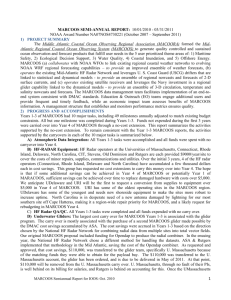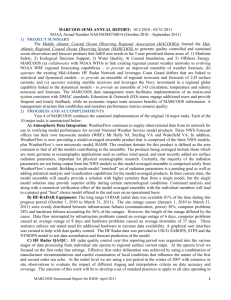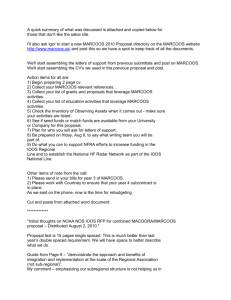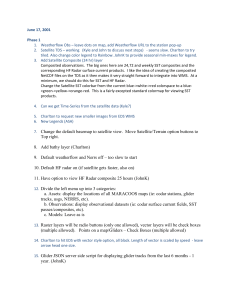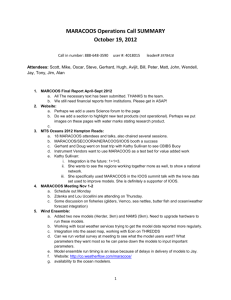October 2010 Semi-Annual Report
advertisement
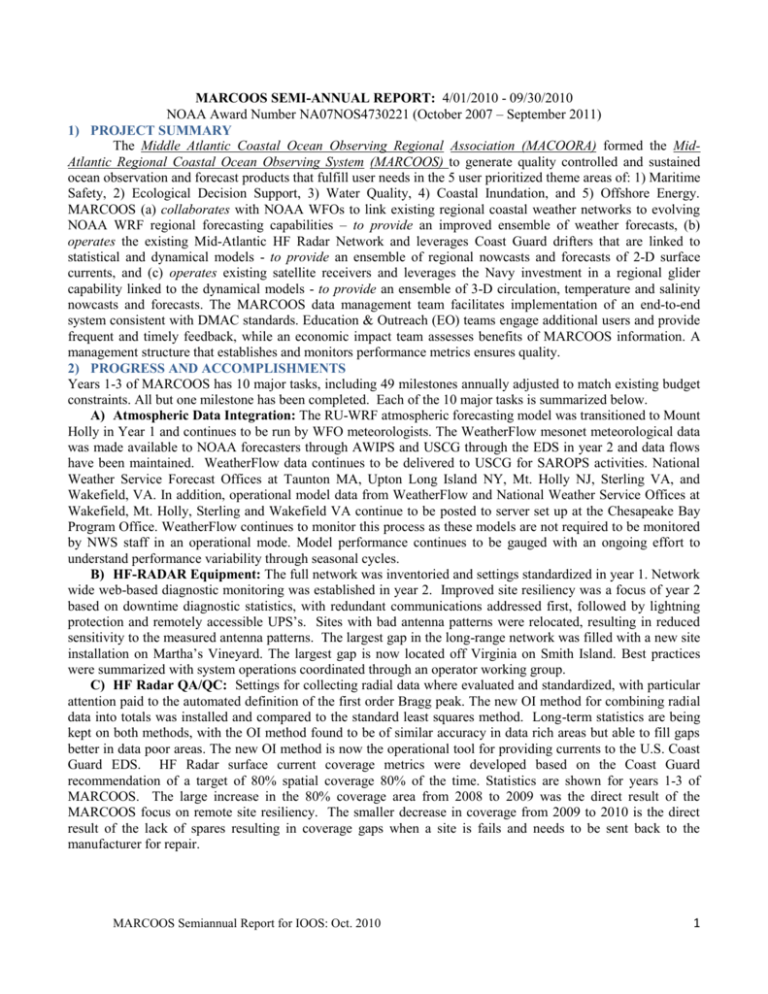
MARCOOS SEMI-ANNUAL REPORT: 4/01/2010 - 09/30/2010 NOAA Award Number NA07NOS4730221 (October 2007 – September 2011) 1) PROJECT SUMMARY The Middle Atlantic Coastal Ocean Observing Regional Association (MACOORA) formed the MidAtlantic Regional Coastal Ocean Observing System (MARCOOS) to generate quality controlled and sustained ocean observation and forecast products that fulfill user needs in the 5 user prioritized theme areas of: 1) Maritime Safety, 2) Ecological Decision Support, 3) Water Quality, 4) Coastal Inundation, and 5) Offshore Energy. MARCOOS (a) collaborates with NOAA WFOs to link existing regional coastal weather networks to evolving NOAA WRF regional forecasting capabilities – to provide an improved ensemble of weather forecasts, (b) operates the existing Mid-Atlantic HF Radar Network and leverages Coast Guard drifters that are linked to statistical and dynamical models - to provide an ensemble of regional nowcasts and forecasts of 2-D surface currents, and (c) operates existing satellite receivers and leverages the Navy investment in a regional glider capability linked to the dynamical models - to provide an ensemble of 3-D circulation, temperature and salinity nowcasts and forecasts. The MARCOOS data management team facilitates implementation of an end-to-end system consistent with DMAC standards. Education & Outreach (EO) teams engage additional users and provide frequent and timely feedback, while an economic impact team assesses benefits of MARCOOS information. A management structure that establishes and monitors performance metrics ensures quality. 2) PROGRESS AND ACCOMPLISHMENTS Years 1-3 of MARCOOS has 10 major tasks, including 49 milestones annually adjusted to match existing budget constraints. All but one milestone has been completed. Each of the 10 major tasks is summarized below. A) Atmospheric Data Integration: The RU-WRF atmospheric forecasting model was transitioned to Mount Holly in Year 1 and continues to be run by WFO meteorologists. The WeatherFlow mesonet meteorological data was made available to NOAA forecasters through AWIPS and USCG through the EDS in year 2 and data flows have been maintained. WeatherFlow data continues to be delivered to USCG for SAROPS activities. National Weather Service Forecast Offices at Taunton MA, Upton Long Island NY, Mt. Holly NJ, Sterling VA, and Wakefield, VA. In addition, operational model data from WeatherFlow and National Weather Service Offices at Wakefield, Mt. Holly, Sterling and Wakefield VA continue to be posted to server set up at the Chesapeake Bay Program Office. WeatherFlow continues to monitor this process as these models are not required to be monitored by NWS staff in an operational mode. Model performance continues to be gauged with an ongoing effort to understand performance variability through seasonal cycles. B) HF-RADAR Equipment: The full network was inventoried and settings standardized in year 1. Network wide web-based diagnostic monitoring was established in year 2. Improved site resiliency was a focus of year 2 based on downtime diagnostic statistics, with redundant communications addressed first, followed by lightning protection and remotely accessible UPS’s. Sites with bad antenna patterns were relocated, resulting in reduced sensitivity to the measured antenna patterns. The largest gap in the long-range network was filled with a new site installation on Martha’s Vineyard. The largest gap is now located off Virginia on Smith Island. Best practices were summarized with system operations coordinated through an operator working group. C) HF Radar QA/QC: Settings for collecting radial data where evaluated and standardized, with particular attention paid to the automated definition of the first order Bragg peak. The new OI method for combining radial data into totals was installed and compared to the standard least squares method. Long-term statistics are being kept on both methods, with the OI method found to be of similar accuracy in data rich areas but able to fill gaps better in data poor areas. The new OI method is now the operational tool for providing currents to the U.S. Coast Guard EDS. HF Radar surface current coverage metrics were developed based on the Coast Guard recommendation of a target of 80% spatial coverage 80% of the time. Statistics are shown for years 1-3 of MARCOOS. The large increase in the 80% coverage area from 2008 to 2009 was the direct result of the MARCOOS focus on remote site resiliency. The smaller decrease in coverage from 2009 to 2010 is the direct result of the lack of spares resulting in coverage gaps when a site is fails and needs to be sent back to the manufacturer for repair. MARCOOS Semiannual Report for IOOS: Oct. 2010 1 % Coverage CODAR OI 2008 % Coverage CODAR OI 2009 % Coverage CODAR OI 2010 Figure 1. Annual CODAR percent coverage averages using optimal interpolation. D) Underwater Gliders: The first MARCOOS glider was purchased in year 1. Leveraging ONR support, the MARCOOS-wide glider capability with coordinated operations was developed and demonstrated in year 2. A demonstration project year 3 leveraging for Vectors a coupled glider/forecast model Average Vectorswas conducted in Average Vectors NSF OOI support Average OSSE. Results demonstrating the impact of IOOS data on fisheries have been presented at fisheries council 2008 2009 2010 meetings. Currently a glider is currently deployed and is conducting a survey of the MARCOOS domain. This completes the 4 deployments conducted over the 2010 field effort. The results of the OOI/MARCOOS effort during November 2009 were published in EOS in September 2010. This complements two glider papers that are currently being revised for publication in the special issue of MTS dedicated to IOOS. Glider data has been transferred to the MARCOOS data management infrastructure making it available for data assimilation. E) Satellites: To support efforts during the Gulf spill, we enlarged our real-time Google Earth displays of cloud-filtered Sea Surface Temperature and Chlorophyll coverage area to span from Cuba north to Newfoundland (http://modata.ceoe.udel.edu/web_kmzs/MARCOOS%20Satellite%20Product s.kmz). This includes the Gulf of Mexico. We are also converting our file format to netCDF4 to increase data storage and ease of data access. We have also released a new near-shore salinity product (out to 50km offshore). This product is a first satellite derived salinity climatology for this region and is ready for model assimilation (Figure 2). Real-time implementation of coastal salinity is on going. We are also working on real-time applications of water mass products from space. We are also starting three fisheries projects, which focus on using satellite products to describe the habitats of squid and Figure 2. Salinity climatology. butterfish (both commercially harvested), sturgeon in Delaware Bay (protected) and tiger sharks near Bermuda (protected). We have also installed and are collecting data from a new satellite receiving station at the University of Delaware that will augment our existing data collecting capacity. Also, we have had more than 1000 people (k-12 to US Senators) this year visit our visualization lab, where they have learned about IOOS ad MARCOOS. F) Short Term Prediction System (STPS): The Short Term Prediction System was extended from Block Island Sound to the full MARCOOS domain in year 1 and has been running in real time since then. Quantitative evaluation of the STPS forecast errors using the HF RADAR data acquired after the forecasts were made have been extensive. We found it necessary to screen the data employed to locations where estimates were available more than 80% of the time and to exclude samples that differed from the local mean by more than three times the local standard deviation. This restricted the domain where forecasts could be made but also decreased the forecast errors. Evaluation using the Coast Guard drifter data has produced the required uncertainty statistics to set the amplitude and time constants for the random flight dispersion model used by SAROPS. The statistical model is an operational part of the Coast Guard EDS since 2009. Though the area covered by the STPS has expanded the forecast error magnitude and trend remains the same. In the last three years the extent of the HF RADAR array has expanded, the national grid for vectors has been changed to 6km squares and the OI combiner approach has been adopted. We have repeated the error analysis after each of these changes. We also developed and tested an extended STPS version that exploited wind observations at buoys. However, the forecast errors have been MARCOOS Semiannual Report for IOOS: Oct. 2010 2 unchanged. Increasing the station density has made the error map more homogeneous but not substantially decreased the rate of increase or the magnitude of the asymptote of the error trend. We repeated the error analysis by sequentially omitting radials from each station in the network to assess their impact on the forecasts. The results can be viewed at (http://sp.uconn.edu/~odonnell/STPS/STPS_ERROR_Map_Summary.html) G) Dynamic Models: Budget cuts have resulted in the dynamical modeling groups working at reduced capacity for the entire 3 years of MARCOOS. Despite this, all three MARCOOS models were configured for real-time data assimilative forecasts during the 3 year time period. All were ready to participate in the October 2009 OSSE and have been running in real time since then. Datasets used for assimilation normally include the satellite SST and the glider CTD data. Tests with HF Radar assimilation indicate that the brute-force assimilation can improve forecasts of subsurface T/S structures, but it is not straightforward due to the differences in the tidal phasing between the HF Radar data and the model. Fully optimized procedures for HF Radar assimilation remains a research question. Comparisons of model forecasts with USCG drifter data is the only task from year 1-3 of MARCOOS that requires extension into year 4 to fully complete. The reason for the delay is the QA/QC required for the drifter data is more extensive than expected, and will be covered by the ASA DMAC group. It is difficult to go back to past time periods for comparison since the real-time models were not all being run for the time periods covered by the HF Radar and STPS comparisons. H) DMAC: Data Management and Communications progress during this reporting period included participation in RA DMAC conference calls and workshop, IOOS WSDE working group, OGC Working groups, NOAA RA DMAC Workshop. Significant accomplishments include: (a) 5 Thredds Servers (TDS) operational within MARCOOS partners; (b) Implemented Oostethys SOS services connected to Postgres database and a custom SOS service for WeatherFlow; (c) Coordinated with The Chesapeake Bay Observing System (CBOS) data management team; (d) Continued to contribute to the ncWMS open source code base – Jon Blower has integrated this in latest ncWMS release; (e) There has been a large effort to expose all MARCOOS data to Google Earth through use of KML/KMZ - ASA has been writing Matlab code to convert observation and model data to KML/.KMZ and transferred this to the modelers/data providers for operational implementation; (f) Completed analysis and delivery of USCG drifter database to the modelers for model skill assessment for MAB - Processing national region now; (g) Operational status with U.S. Coast Guard SAROPS – EDS - Completion of integration of HF Radar data and STPS derived forecast into USCG SAROPS EDS; (h) Initial implementation on asset map to integrate MARCOOS catalog - The initial version displays the domains of model grids, HF-RADAR, glider deployments and the next step is live data feeds from the models, satellite and in-situ observations, and can be viewed at http://staging.asascience.com/sandbox/cgalvarino/marcoos/; (i) Initial prototyping of OPeNDAP HFRadar Radial File format-module, with HF-Radar Combining module, anticipated access via Antelope as initially implemented at National HF-Radar repository; (j) Extended OPeNDAP Hyrax server front-end to support THREDDS catalog metadata, in particular metadata inheritance within a data repository and added back-end NcML module to support additional aggregation types; and (k) Implemented standalone WCS implementation that exposes OPeNDAP gridded data as WCS coverages via a WCS-1.1.2 interface and public release of Hyrax1.6.2 with the above capabilities. I) Education and Outreach: MARCOOS has helped identify priority observations that could improve water quality in the MAB; through its collaboration with the NWQMN (via its USGS representative E. Vowinkle, Co-PI). The collaboration has enabled product development such as the U. Delaware MARCOOS satellite based chlorophyll product that was used in late August this year to detect a large phytoplankton bloom off coastal New Jersey. A grant from USEPA Region 2, in cooperation with NJDEP Marine Monitoring, supported a glider deployment that provided critical subsurface data. The USEPA and NJDEP used MARCOOS modeling support from Stevens to build a 4-d representation of the bloom that identified potential water quality impacts throughout the water column. In another example, surface current observations, combined with regional ocean model forecasts, were used to successfully back-track the source of medical waste discovered off of an Atlantic County beach at the request of NJDEP. These serve as great examples of the quality of products and support that come from strong partnerships with the growing water quality user community throughout the MAB. Our outreach activities on rip currents with life guards through Sea Grant has evolved into a fully developed program called “Beach Basics” with a 5-year development plan submitted as part of the new project development component of the MARACOOS proposal. Different methodologies for visualizing 3-D datasets by fisherman MARCOOS Semiannual Report for IOOS: Oct. 2010 3 through their preferred web interfaces were tested, resulting in our adoption of multiple 2-D views as the preferred methodology. Preloaded high-resolution images with improved labels were preferred over interactive construction of individual products. Nationally, our most significant outreach activity was response to the Deepwater Horizon Oil Spill, which included deployment of a web portal to help coordinate the national IOOS response, construction of numerous Google Earth interfaces to plan glider missions, writing a coordination blog during the intense response period, sending three gliders to the Gulf (2 RU & 1 U. Delaware), STPS was installed and operated in the regions with HF Radar coverage, briefing state officials including a blog for Virginia, ASA’s support of NOAA through forecasts and data management, and U. Maryland participation in shipboard sampling cruises. The NSF COSEE-NOW was leveraged to produce communication interfaces with teachers, culminating in the Oil Spill Resources website (coseenow.net/blog/oil spill_resources). J) Economic Benefits: The types and economic impacts of fishing activity in the MAB were assessed and summarized in 3 reports available on the MARCOOS website. Work with NOAA fisheries scientists, IOOS scientists and the MARCOOS economic development team has been presented at national/international conferences and at the Northeast Fisheries Council meeting. Work during this 6-month period has focused primarily on updating and expanding our UMCES Technical Report, "The Role of Ocean Observing Systems in Fisheries Management" in order to get it ready to submit for peer-reviewed publication. The technical report, submitted during the previous 6-month period, focused on the use of ocean observing system data in fisheries, specifically its use in coupled biophysical models which can be incorporated into traditional single species approaches, spatial management strategies, and contemporary ecosystem-based fisheries management techniques. It also addressed potential future uses as observing system technologies evolve and improve. We decided the information in this report needs to be supplemented using additional reviews of physical-biological models, and fisheries-environment interactions before it is suitable for publishing. We are, therefore, attempting to analyze the potential effects of reduced uncertainty in management decisions on harvest levels, fish stocks and subsequent value of selected fisheries in the mid-Atlantic. In theory, as uncertainty decreases around management thresholds, such as spawning stock biomass and recruitment, fisheries managers can make more precise decisions regarding allowable harvests of commercially and recreationally important species. These refined decisions about allowable harvests can lead to increases in fishermen's earnings with no additional risk to fish stocks. We are examining what ocean observation data can be used to determine correlations and relationships between environmental conditions and fish population dynamics, which in turn can be used to reduce uncertainty around management decisions and generate fishery-related economic benefits. K) Statistics: New Regional Products: Stevens has developed a cooperative agreement with the NY Harbor PORTS. USGS is leveraging their data management and display system to provide real time river and estuarine data to MARCOOS partners and users. New satellite products include improved declouding of SST, and a new salinity product based on ocean colors. A new HF Radar product is the upwelling/downwelling trend used by the fisheries researchers. A new DO product is being delivered by the gliders. New National products: National HF-RADAR network has begun the validation process for operational status in USCG SAROPS. MARCOOS partners were active participants in the IOOS response to the Deepwater Horizon Oil Spill. Deployed Assets: University of Delaware Satellite Ground Station, 30+ WeatherFlow hurricane hardened weather station sites, Martha’s Vineyard CODAR, three Gliders in the Gulf of Mexico. Assets Removed: None Assets Maintained: 2 Satellite Ground Stations, 30 CODAR sites, over 100 Weather Stations, 2 Glider flights every 6 months for 3 years. Papers published: For an updated list of papers please visit http://maracoos.org/papers. Presentations: Over 150 presentations (http://maracoos.org/workshops_presentations). Data Management: The 14 long range radial sites were operational for 82% of the time from January 1, 2010 to August 31, 2010, contributing data to the National Network. Over 100 weather sites contributed data to AWIPS and EDS. Real-time forecasts were produced by 1 statistical and 3 dynamical models. 3) SCOPE OF FUTURE WORK Year 4 of MARCOOS will focus on transitioning from the delivery of data-based products to forecast based products. Atmospheric group will transition from providing the data to weather forecasters to assembling MARCOOS Semiannual Report for IOOS: Oct. 2010 4 the numerous atmospheric forecasts into an ensemble validated with the WeatherFlow mesonet. The HF Radar group will focus on maintaining the MAB network without sufficient spares. New radars purchased by state and other federal agencies will be added to the network as they become available. DoD has provided half of he funding required for a new HF Radar site that could be matched by NOAA to fill the Smith Island gap. Prompted by the importance of tides in the data assimilation for surface currents, the local focus of the QA/QC group will be a re-evaluation of how radial current maps are generated by each shore site in an effort to improve the accuracy of maps made over shorter time intervals to better resolve the tides. This group also has a national focus on an evaluation of the OI parameters for making total vector current maps from radial currents for inclusion of the national network in the Coast Guard EDS for SAROPS. Year 4 of MARCOOS will include fall and spring glider flights as we build the fleet in preparation for the MARACOOS flight triangles. The fall 2010 flights are being conducted with RU22 running on rechargeable lithium batteries. The transition from zig-zag flight tracks that span the region to simultaneous flight triangles will begin in this year. A new European satellite carrying an AVHRR sensor is being added to the MARCOOS data set. The new U. Delaware X-Band satellite dish will be made operational, and when that system is available as backup, the Rutgers antennas will undergo a long awaited software upgrade. New products will be evaluated. STPS will be maintained in the MAB with coverage extended into the bays and will continue to be evaluated as the HF Radar network is improved. Real time operations of the data assimilative dynamical models will be maintained. Forecasts will be evaluated using USCG drifter data that is quality controlled by ASA. Use of Google Maps and Google Earth will be expanded. The transition to the joint MARACOOS website will be completed. New multi-media products for MARACOOS will be developed for distribution through the website. Beach Basics will be fully planned for potential implementation by MARACOOS in 2011. The economic impact team will transition from a fisheries focus from the first 3 years to a focus on Beach Basics in preparation for MARACOOS. 4) LEADERSHIP PERSONELL AND ORGANIZATIONAL STRUCTURE Michael Crowley has joined the MARCOOS leadership team as the observatory operations manager at the ¼ time level, brining over 20 years of ocean observing experience. There are no other significant changes. 5) BUDGET ANALYSIS The 3-year MARCOOS budget # Distribution Years 1-3 Awarded Remaining Balance $1,761,458 $0 includes Rutgers expenses of $1,761,458 plus 1 Lead: Rutgers University 2 Applied Science $206,498 $16.68 $3,338,542 in subawards for a total of 3 Center for Innovative Technology $90,000 $8,229.02 $75,000 $22,520.98 $5,100,000. All Rutgers expenditures were 4 Monmouth University $299,000 $33,365.92 completed prior to the original end date of the 5 Old Dominion University 6 Stevens Institute of Technology $343,154 $10,663.03 MARCOOS contract, leaving zero balance for 7 University of Connecticut $446,000 $60,862.54 $186,550 $53,863.01 Rutgers. All subawards were delivered to 8 University of Delaware (2) of Massachusetts $688,000 $66,110.50 subcontractors at the beginning of each fiscal 910 University University of North Carolina $56,000 $9,678.00 year. The amount awarded to each 11 University of Rhode Island $165,628 $43,268.00 $270,000 $0 subcontractor is listed in the table. Billing on 12 Weatherflow 13 University of Maryland (2) $345,000 $11,196.04 subcontracts historically lags the actual work 14 OPeNDAP* $167,712 $118,275.92 done and the resulting generation of invoices TOTAL AWARDED $5,100,000 $438,049.67 by universities. There is little individual PI’s *Re-budget request approved to use OPeNDAP funds for new glider purchase. can do about their university billing cycles. Private companies are much more prompt in their billing. We have requested and received a 1 year no cost extension to allow for the normal university billing cycle on work completed in MARCOOS years 1-3. This is the case for most subawards, with three exceptions. One modeling task remaining from year 3 is the validation of the data assimilative forecasts. For the reasons discussed above, that task is extending into year 4. The second exception is Monmouth University, whose major task is interaction with the governor’s regional alliance MARCO. MARCO is still in the formation process, and is expected to become more active in the coming year where the remaining Monmouth funds will be spent. The last exception is Opendap. Closing out the Opendap account for years 1-3 left $118,275.92 in their budget. It was determined by the MARCOOS DMAC Team that Opendap could not effectively spend that amount of funds during an extension year based on the present data management needs. The DMAC Team concluded that the unspent funds were best redirected to the Glider Team whose need for a second glider to complete MARCOOS year 4 superseded all other needs. The rebudgeting request has been approved by NOAA. MARCOOS Semiannual Report for IOOS: Oct. 2010 5
